Compositional and Structural Disorder in Two-Dimensional AIIIBVI Materials
Abstract
1. Introduction
2. Materials and Methods
3. Results
3.1. Compositional Disorder
3.2. Structural Disorder
4. Conclusions
Author Contributions
Funding
Data Availability Statement
Conflicts of Interest
References
- Fiori, G.; Bonaccorso, F.; Iannaccone, G.; Palacios, T.; Neumaier, D.; Seabaugh, A.; Colombo, L. Electronics based on two-dimensional materials. Nat. Nanotechnol. 2014, 9, 768–779. [Google Scholar] [CrossRef]
- Zhang, X.; Li, J.; Zhou, X. Tunable bandgap and vacancy defects in GaSe/SnSe van der Waals heterostructure. J. Mater. Res. 2021, 36, 4927–4937. [Google Scholar] [CrossRef]
- Zhao, Q.; Frisenda, R.; Wang, T.; Castellanos-Gomez, A. InSe: A two-dimensional semiconductor with superior flexibility. Nanoscale 2019, 11, 9845–9850. [Google Scholar] [CrossRef]
- Bakaul, S.R.; Serrao, C.R.; Lee, M.; Yeung, C.W.; Sarker, A.; Hsu, S.L.; Salahuddin, S. Single crystal functional oxides on silicon. Nat. Commun. 2016, 7, 10547. [Google Scholar] [CrossRef]
- Kim, S.J.; Choi, K.; Lee, B.; Kim, Y.; Hong, B.H. Materials for flexible, stretchable electronics: Graphene and 2D materials. Annu. Rev. Mater. Res. 2015, 45, 63–84. [Google Scholar] [CrossRef]
- Zhang, Y.; Ding, W.; Chen, Z.; Guo, J.; Pan, H.; Li, X.; Xie, W. Layer-Dependent Magnetism in Two-Dimensional Transition-Metal Chalcogenides MnTn+ 1 (M= V, Cr, and Mn; T= S, Se, and Te; and n= 2, 3, and 4). J. Phys. Chem. C 2021, 125, 8398–8406. [Google Scholar] [CrossRef]
- Jeong, J.; Choi, Y.H.; Jeong, K.; Park, H.; Kim, D.; Cho, M.H. Evolution of the broadband optical transition in large-area MoSe2. Phys. Rev. B 2018, 97, 075433. [Google Scholar] [CrossRef]
- Srour, J.; Badawi, M.; El Haj Hassan, F.; Postnikov, A.V. Crystal structure and energy bands of (Ga/In) Se and Cu (In, Ga) Se2 semiconductors in comparison. Phys. Status Solidi 2016, 253, 1472–1475. [Google Scholar] [CrossRef]
- Gencarelli, F.; Vincent, B.; Demeulemeester, J.; Vantomme, A.; Moussa, A.; Franquet, A.; Heyns, M. Crystalline properties and strain relaxation mechanism of CVD grown GeSn. ECS J. Solid State Sci. Technol. 2013, 2, P134. [Google Scholar] [CrossRef]
- Bodlos, R.; Dengg, T.; Ruban, A.V.; Dehghani, M.; Romaner, L.; Spitaler, J. Ab-initio investigation of the atomic volume, thermal expansion, and formation energy of WTi solid solutions. Phys. Rev. Mater. 2021, 5, 043601. [Google Scholar]
- Li, X.; Li, L.; Wu, M. Various polymorphs of group III–VI (GaSe, InSe, GaTe) monolayers with quasi-degenerate energies: Facile phase transformations, high-strain plastic deformation, and ferroelastic switching. Mater. Today Phys. 2020, 15, 100229. [Google Scholar] [CrossRef]
- Sun, Y.; Li, Y.; Li, T.; Biswas, K.; Patanè, A.; Zhang, L. New polymorphs of 2D indium selenide with enhanced electronic properties. Adv. Funct. Mater. 2020, 30, 2001920. [Google Scholar] [CrossRef]
- Venanzi, T.; Arora, H.; Winnerl, S.; Pashkin, A.; Chava, P.; Patanè, A.; Schneider, H. Photoluminescence dynamics in few-layer InSe. Phys. Rev. Mater. 2020, 4, 044001. [Google Scholar] [CrossRef]
- Song, C.; Fan, F.; Xuan, N.; Huang, S.; Zhang, G.; Wang, C.; Yan, H. Largely tunable band structures of few-layer InSe by uniaxial strain. ACS Appl. Mater. Interfaces 2018, 10, 3994–4000. [Google Scholar] [CrossRef]
- Zhang, Z.; Yuan, Y.; Zhou, W.; Chen, C.; Yuan, S.; Zeng, H.; Zhang, W. Strain-induced bandgap enhancement of InSe ultrathin films with self-formed two-dimensional electron gas. ACS Nano 2021, 15, 10700–10709. [Google Scholar] [CrossRef]
- Kosobutsky, A.V.; Sarkisov, S.Y. Influence of size effects on the electronic structure of hexagonal gallium telluride. Phys. Solid State 2018, 60, 1686–1690. [Google Scholar] [CrossRef]
- Başol, B.M. Low cost techniques for the preparation of Cu (In, Ga)(Se, S)2 absorber layers. Thin Solid Film. 2000, 361, 514–519. [Google Scholar] [CrossRef]
- Gauthier, M.; Polian, A.; Besson, J.M.; Chevy, A. Optical properties of gallium selenide under high pressure. Phys. Rev. B 1989, 40, 3837. [Google Scholar] [CrossRef]
- Ghalouci, L.; Taibi, F.; Ghalouci, F.; Bensaid, M.O. Ab initio investigation into structural, mechanical and electronic properties of low pressure, high pressure and high pressure-high temperature phases of Indium Selenide. Comput. Mater. Sci. 2016, 124, 62–77. [Google Scholar] [CrossRef]
- Borisenko, E.; Borisenko, D.; Timonina, A.; Kolesnikov, N. Nonvariant polymorphic transition from hexagonal to monoclinic lattice in GaTe single crystal. J. Cryst. Growth 2020, 535, 125548. [Google Scholar] [CrossRef]
- Schwarz, U.; Syassen, K.; Kniep, R. Structural phase transition of GaTe at high pressure. J. Alloys Compd. 1995, 224, 212–216. [Google Scholar] [CrossRef]
- Clark, S.J.; Segall, M.D.; Pickard, C.J.; Hasnip, P.J.; Probert, M.I.; Refson, K.; Payne, M.C. First principles methods using CASTEP. Z. Für Krist.-Cryst. Mater. 2005, 220, 567–570. [Google Scholar] [CrossRef]
- Perdew, J.P.; Burke, K.; Ernzerhof, M. Generalized gradient approximation made simple. Phys. Rev. Lett. 1996, 77, 3865. [Google Scholar] [CrossRef]
- Barzilai, J.; Borwein, J.M. Two-point step size gradient methods. IMA J. Numer. Anal. 1988, 8, 141–148. [Google Scholar] [CrossRef]
- Tkatchenko, A.; DiStasio, R.A., Jr.; Car, R.; Scheffler, M. Accurate and efficient method for many-body van der Waals interactions. Phys. Rev. Lett. 2012, 108, 236402. [Google Scholar] [CrossRef]
- Segura, A. Layered indium selenide under high pressure: A review. Crystals 2018, 8, 206. [Google Scholar] [CrossRef]

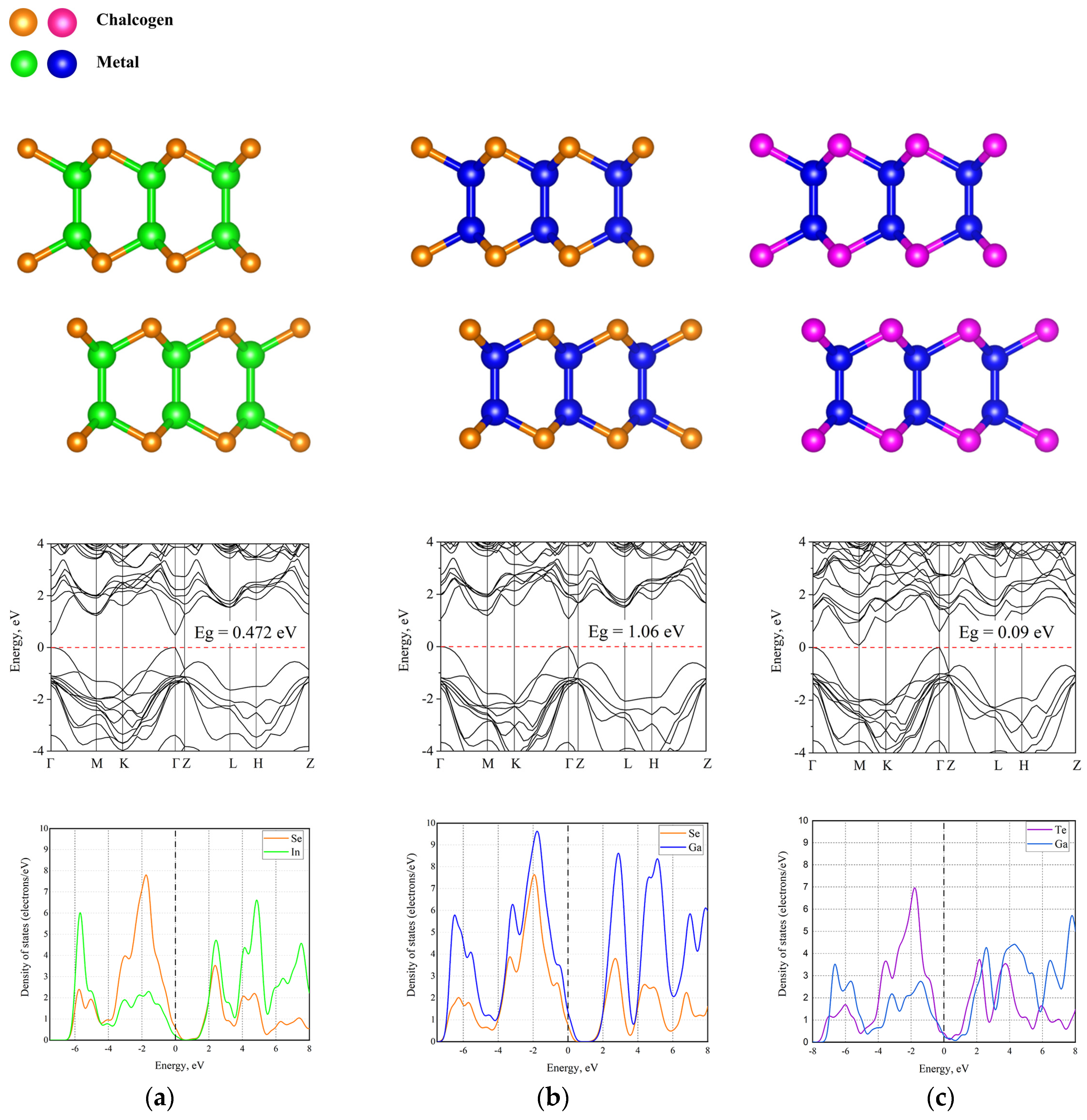
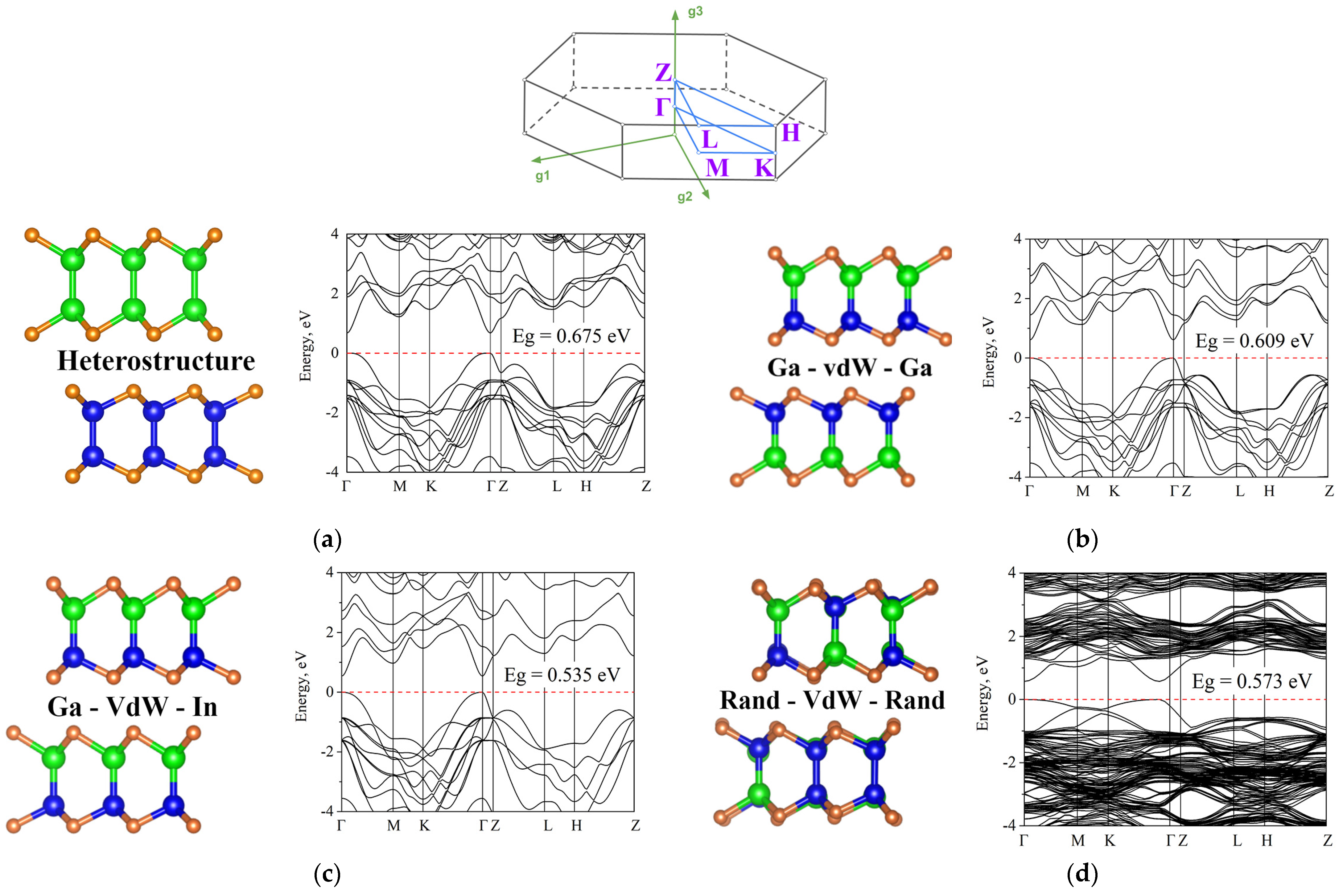
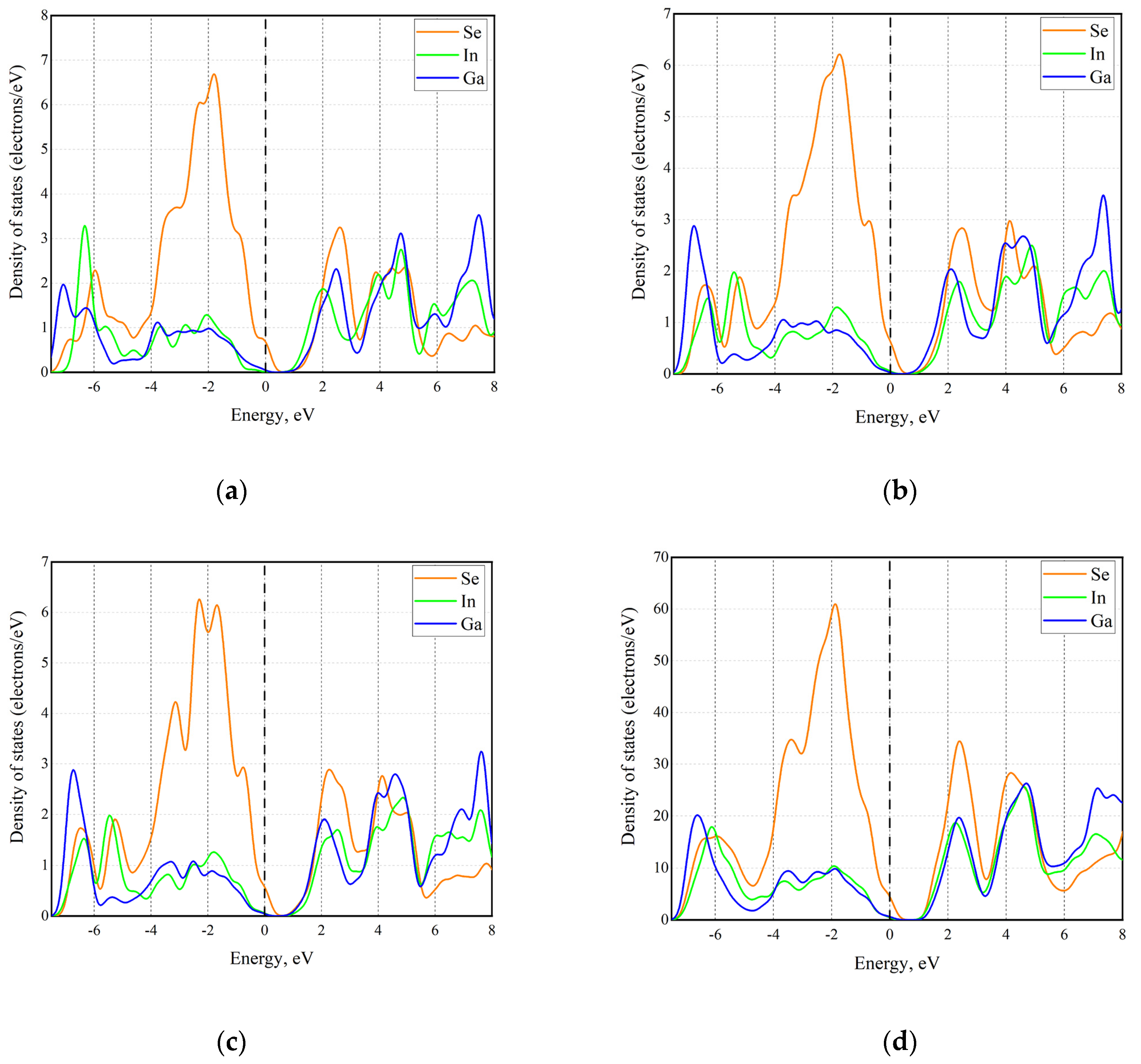
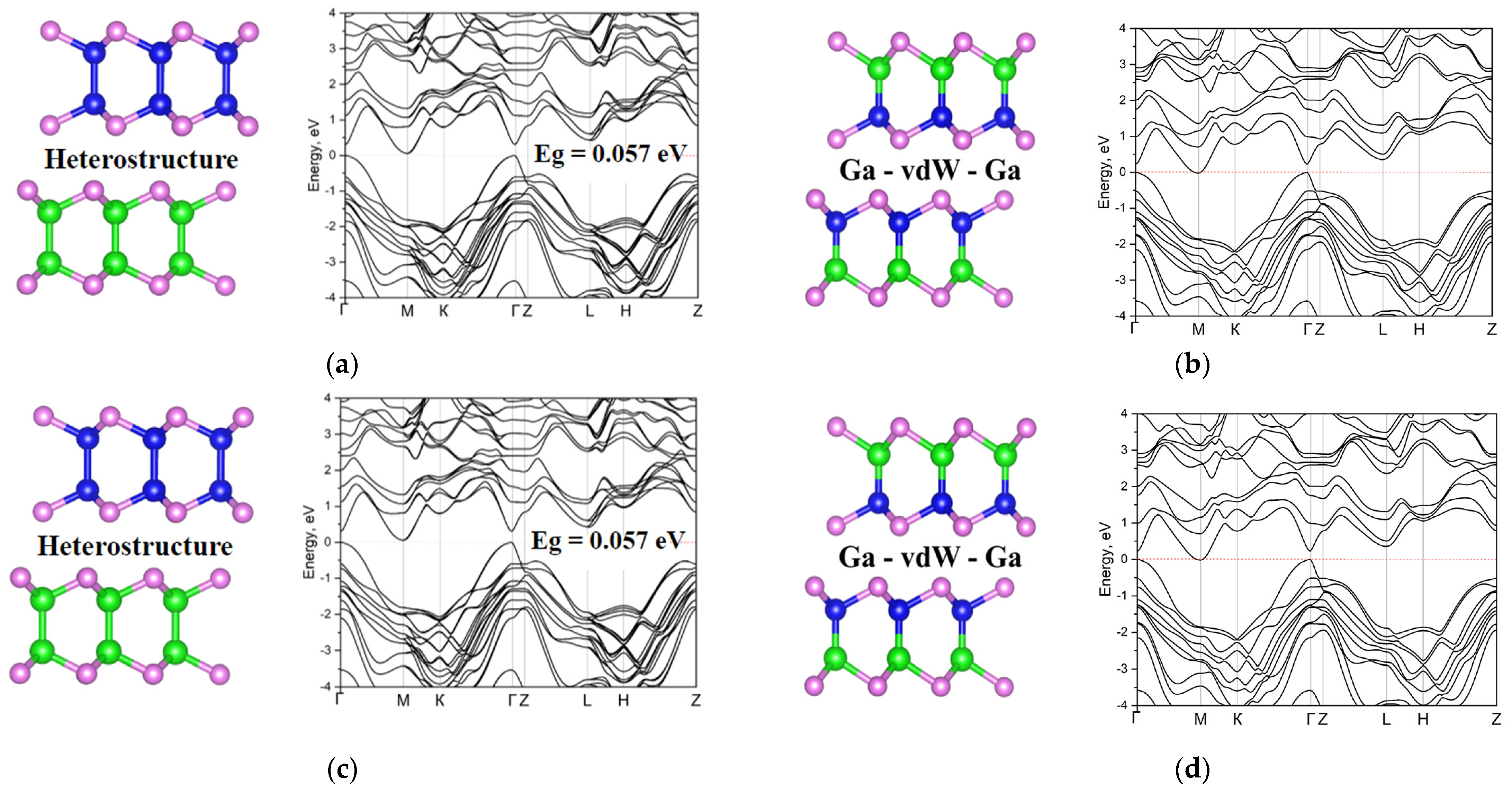



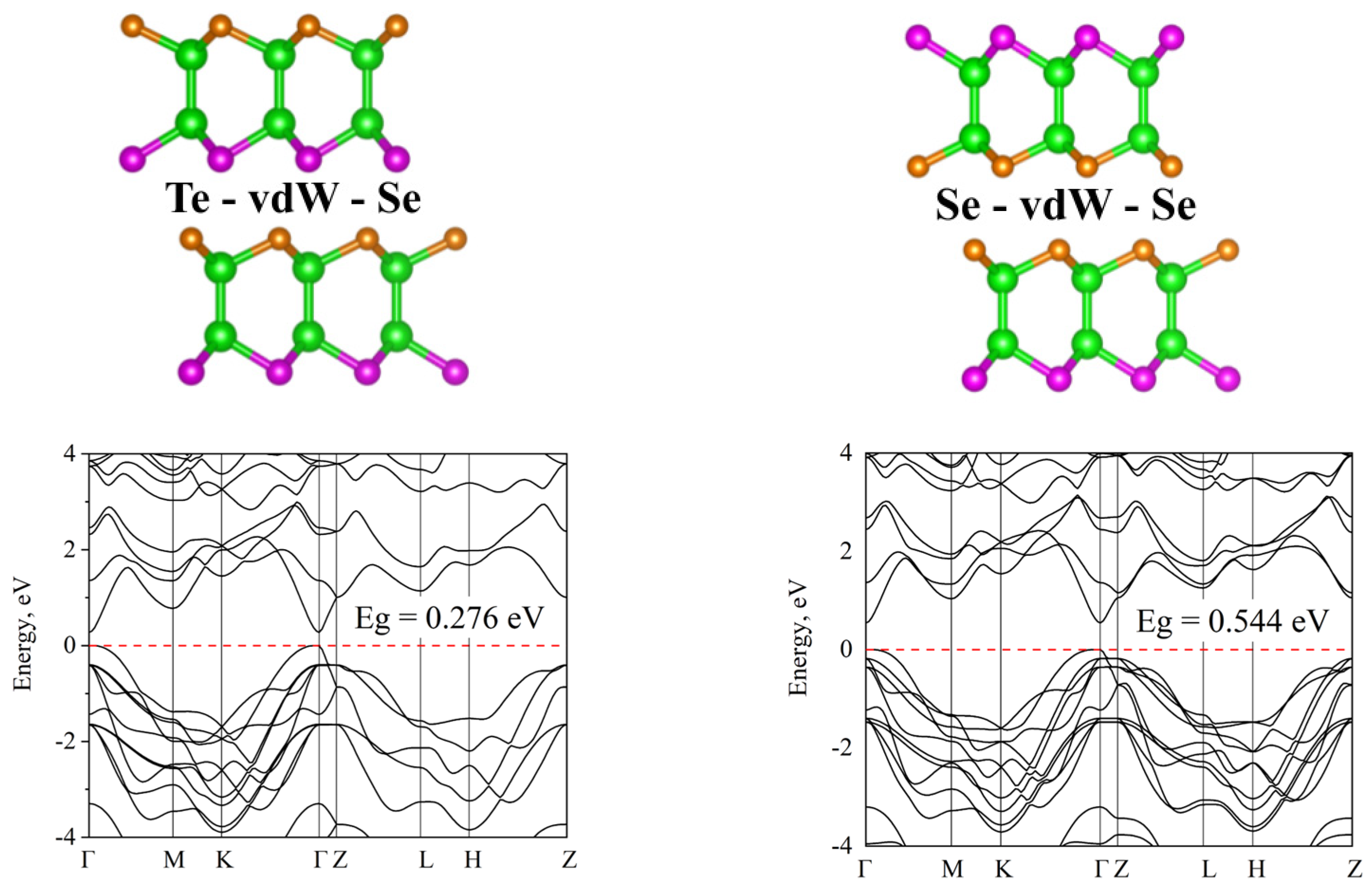
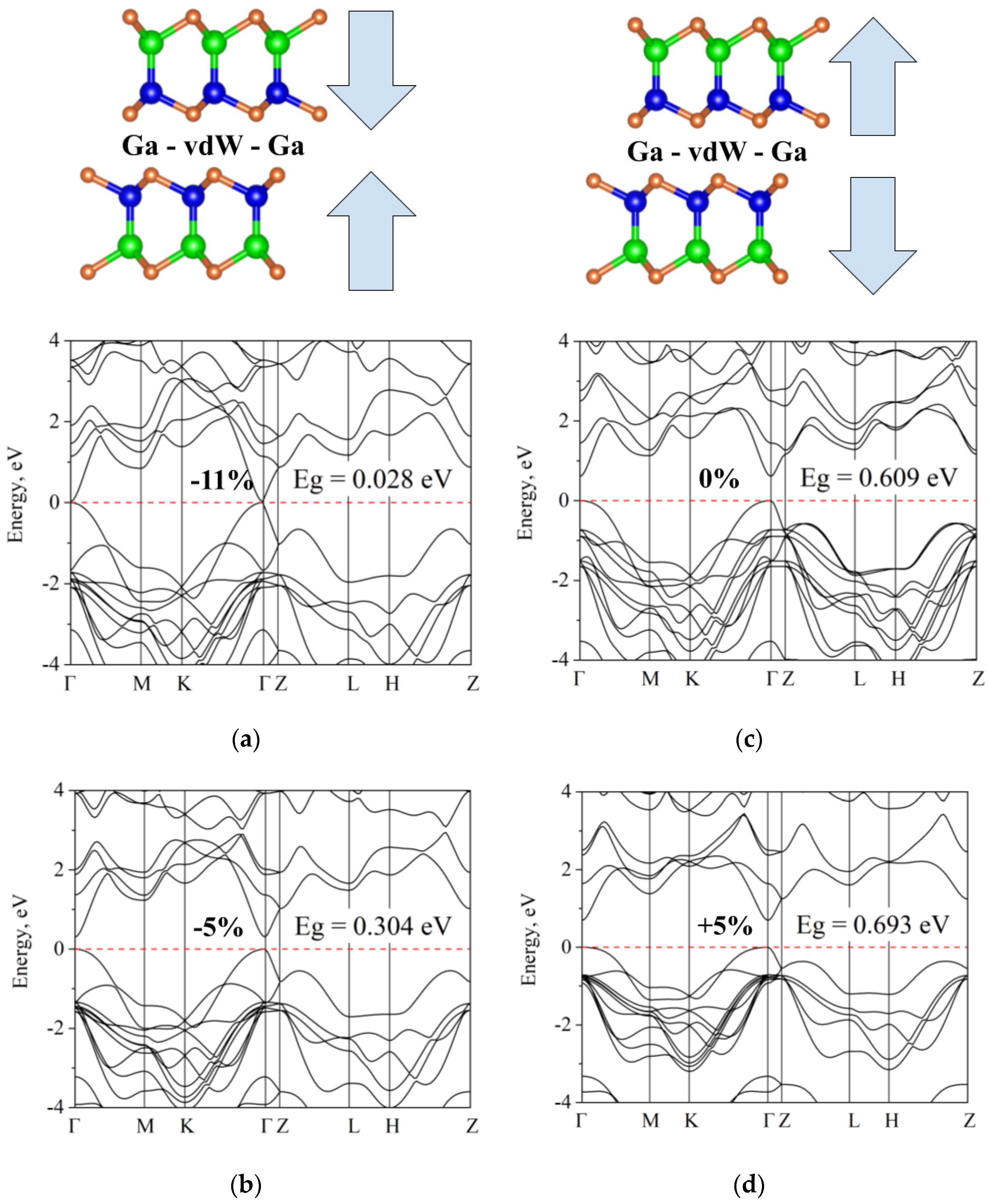
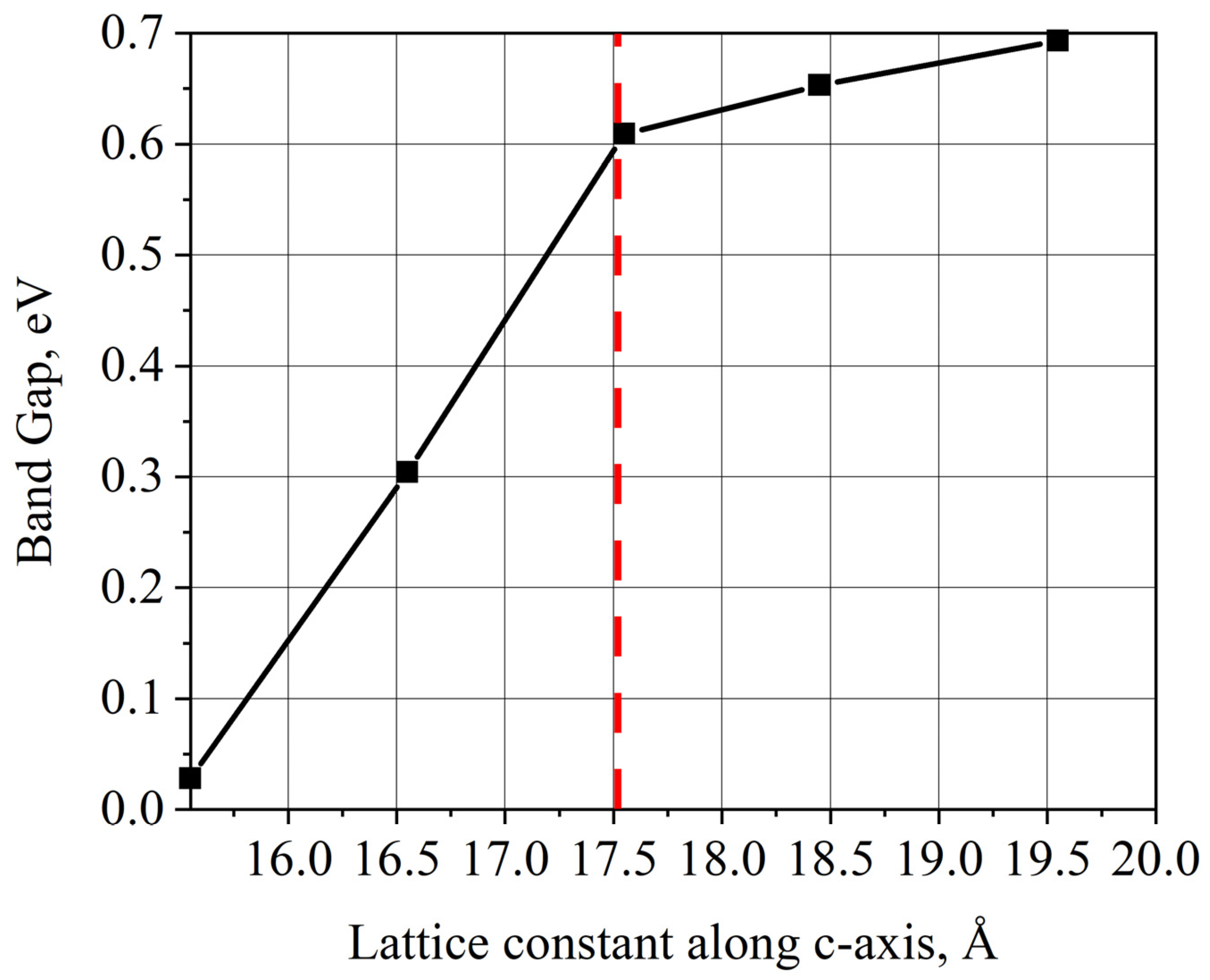
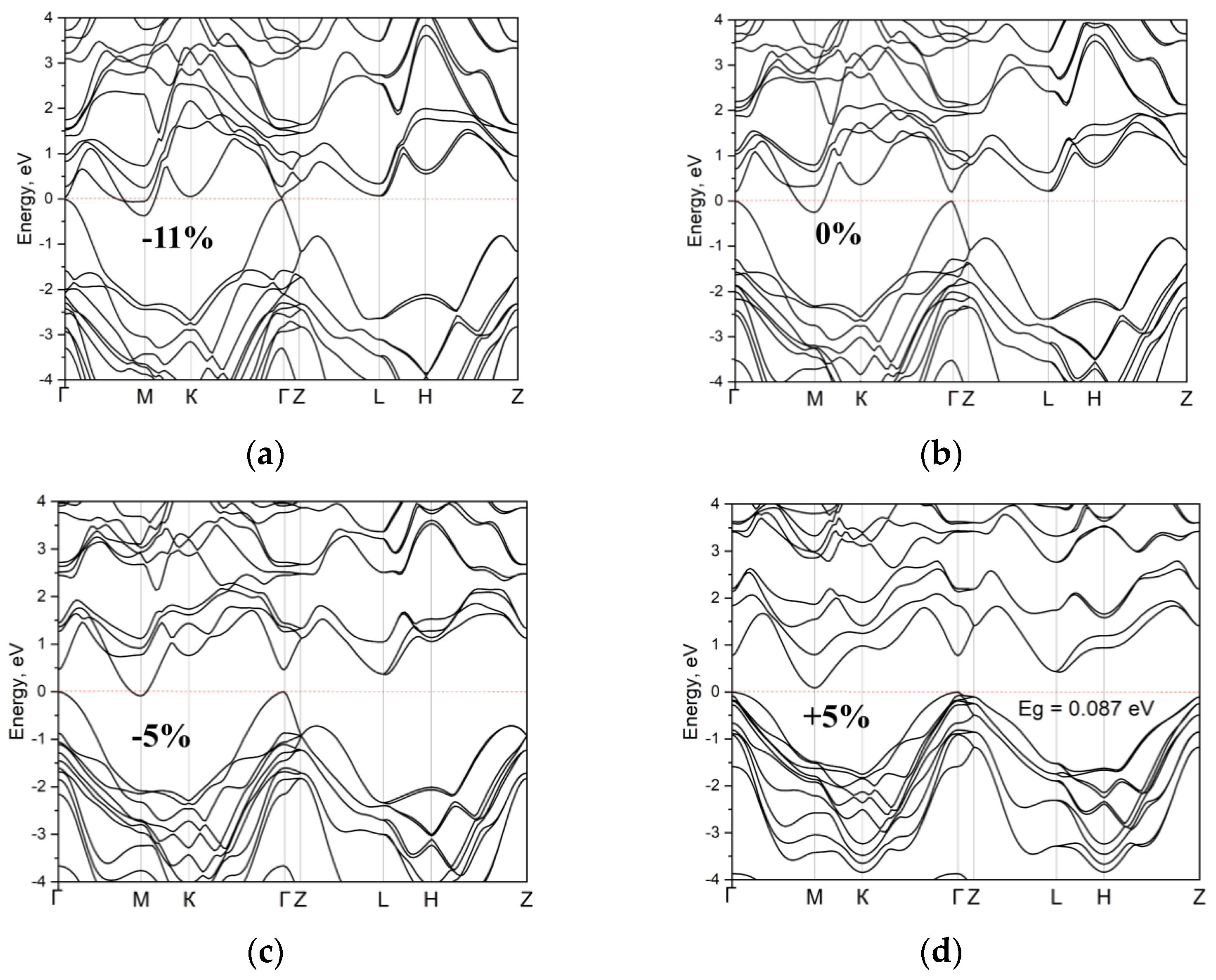

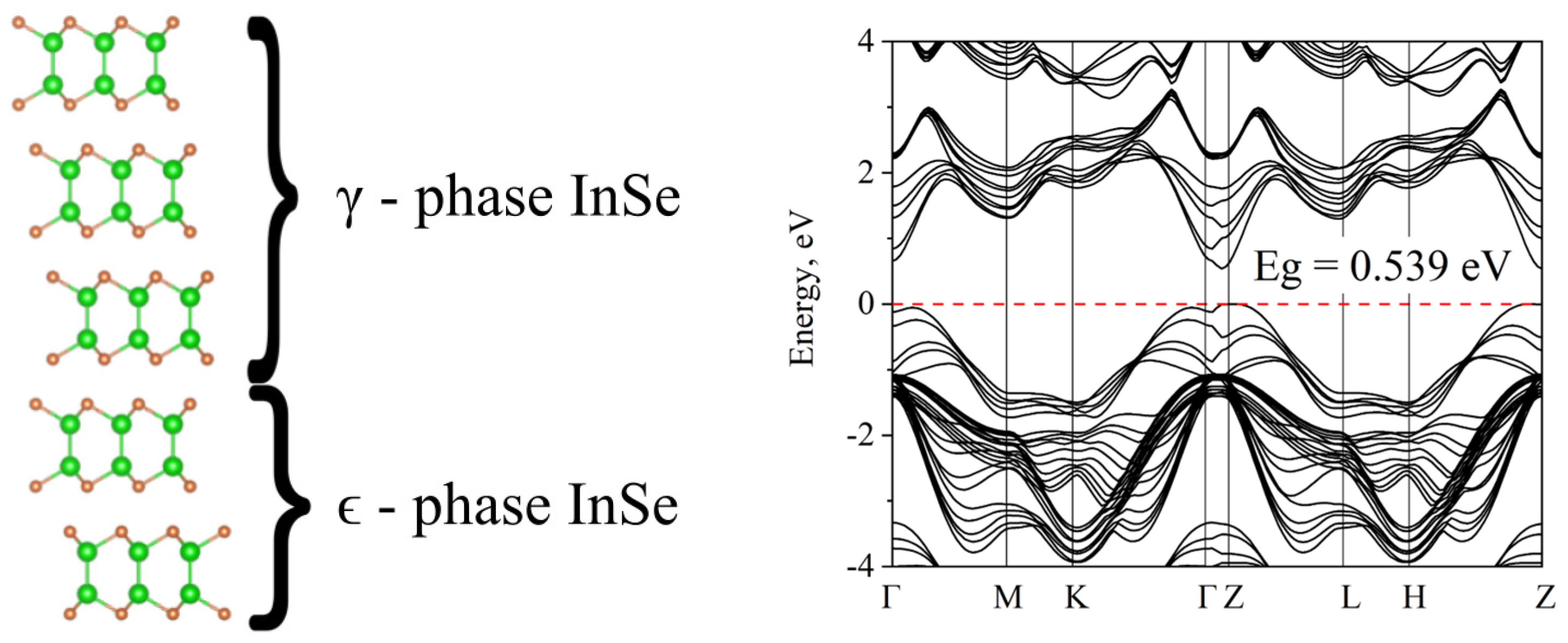
Disclaimer/Publisher’s Note: The statements, opinions and data contained in all publications are solely those of the individual author(s) and contributor(s) and not of MDPI and/or the editor(s). MDPI and/or the editor(s) disclaim responsibility for any injury to people or property resulting from any ideas, methods, instructions or products referred to in the content. |
© 2023 by the authors. Licensee MDPI, Basel, Switzerland. This article is an open access article distributed under the terms and conditions of the Creative Commons Attribution (CC BY) license (https://creativecommons.org/licenses/by/4.0/).
Share and Cite
Stepanov, R.S.; Marland, P.I.; Kolobov, A.V. Compositional and Structural Disorder in Two-Dimensional AIIIBVI Materials. Crystals 2023, 13, 1209. https://doi.org/10.3390/cryst13081209
Stepanov RS, Marland PI, Kolobov AV. Compositional and Structural Disorder in Two-Dimensional AIIIBVI Materials. Crystals. 2023; 13(8):1209. https://doi.org/10.3390/cryst13081209
Chicago/Turabian StyleStepanov, Roman S., Pavel I. Marland, and Alexander V. Kolobov. 2023. "Compositional and Structural Disorder in Two-Dimensional AIIIBVI Materials" Crystals 13, no. 8: 1209. https://doi.org/10.3390/cryst13081209
APA StyleStepanov, R. S., Marland, P. I., & Kolobov, A. V. (2023). Compositional and Structural Disorder in Two-Dimensional AIIIBVI Materials. Crystals, 13(8), 1209. https://doi.org/10.3390/cryst13081209





